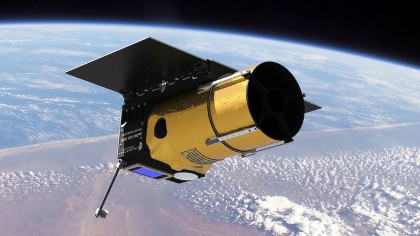Can tech save us from giant asteroids like 2015 TB145?
We're safe on 31 October, but is Earth a sitting duck?
At 3 x 1.65m and 2,800kg, the LSST's camera – now under construction – is about the same size as a car, and the largest even constructed. Able to photograph the night sky in six colours, from near ultraviolet to to near infrared, it will reach a stunning 3,200-megapixel (actually 3.2 gigapixels) resolution by using a mosaic of 189 16-megapixel silicon detectors arranged on 21 sections.
"The LSST project will certainly accelerate our discovery rate," says Moskovitz. "The good news is that we are getting very good at finding objects like TB145, so any impact hazard that these objects may pose is slowly being eliminated." Moskovitz thinks that within a couple of decades we will effectively know about all TB145-like objects in the vicinity, and won't have to worry about getting hit by one – and happily, the chances of us being hit in the meantime are small.
Privatising asteroid-hunting… and mining

NASA is also eyeing asteroids not as potential threats, but as possible stepping stones to deep space, with backing from private company Planetary Resources. Why is private money involved? Asteroids present a near-infinite supply of rare-Earth metals, that's why. Planetary Resources – whose investors include Richard Branson and Google's Larry Page and Eric Schmidt – want to use the ARKYD space telescope to identify near-Earth asteroids that could be commercially mined.
How to see 2015 TB145
Stargazers and amateur astronomers will get a treat this Halloween, but TB145 will be tricky to observe. "Amateurs with a small backyard telescope may be able to observe the object as it passes," says Moskovitz. Bigger and closer than most asteroid passes, TB145 will be unusually bright, and visible in the eastern night sky on 31 October – Halloween night – near the constellation of Orion. However, the Moon, which TB145 will pass just beyond, will be only just on the wane from full, so very bright – and you'll need a minimum 4-inch telescope to stand any chance of spotting the asteroid.
There's some great advice on aiming a telescope at TB145 here, and the event will also be covered live on the web here. Meanwhile, NASA will be mapping TB145 by bouncing radio waves off the asteroid, collecting radar echoes in radio telescopes at the Arecibo Observatory in Puerto Rico and the Green Bank Telescope in West Virginia.
Get daily insight, inspiration and deals in your inbox
Sign up for breaking news, reviews, opinion, top tech deals, and more.
Jamie is a freelance tech, travel and space journalist based in the UK. He’s been writing regularly for Techradar since it was launched in 2008 and also writes regularly for Forbes, The Telegraph, the South China Morning Post, Sky & Telescope and the Sky At Night magazine as well as other Future titles T3, Digital Camera World, All About Space and Space.com. He also edits two of his own websites, TravGear.com and WhenIsTheNextEclipse.com that reflect his obsession with travel gear and solar eclipse travel. He is the author of A Stargazing Program For Beginners (Springer, 2015),
